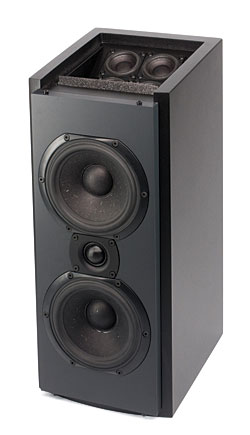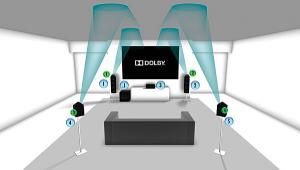The Ultimate Test: Dolby Atmos vs. Dolby Atmos Page 2
Testing, Testing: 5.1.2, 5.1.4
After Mike Trei finished giving the Yamaha Aventage RX-A2040 AV receiver a workout for his recent review, Rob had it shipped to me to use as the heart of these Dolby Atmos test systems. It’s a $1,700 AVR (one down from the 2014 top-of-the-line) with nine 140-watt channels—and an Atmos firmware update. In order to facilitate testing the differences between the ceiling and non-ceiling speaker configurations, Triad volunteered to provide two pair of the company’s new Atmos-enabled InRoom Bronze LR-H monitors for use in the front and main surround positions, a matching InRoom Bronze Center for the center channel, four (yes, four) InWall Bronze/4 SlimSubs, and two pair of InCeiling Bronze/8 ceiling speakers that I could swap with the InRoom monitors. Since it’s already compatible with Atmos, I used my Oppo BDP-105 Blu-ray player. Oh, yeah, I also worked the crap out of my trusty RadioShack analog sound pressure meter. (It’s Atmos-compatible, too.)

Even if there had been tons of Atmos speakers on the market, it’s still highly likely that we’d have chosen to use the Triad models listed above because the company makes a serious effort to design speakers within the same series (in this case, Bronze) to be as close as possible in tonal balance. The goal is that an InCeiling Bronze/8 should sound double-damn close to an InRoom Bronze Center or LCR, and all of those should sound likewise to the LR section of the InRoom Bronze LR-H (the “H” being the integrated Atmos-enabled elevation module). My experience with Triad in the past has borne this out, and in my opinion, they’re one of the best speaker companies at regularly accomplishing this feat. And it’s a feat that was important for these tests because we wanted to make sure that the differences we heard were the result of speaker placement and configuration, not significant discrepancies in tonal balance among the speakers. (In addition to this Atmos versus Atmos comparison, see my review of a 5.1.4 system based on the Triad InRoom Bronze LR-H monitor.)
 It may sound like a simple task, but switching from a 5.1.2 Atmos in-ceiling configuration to a 5.1.2 Atmos-enabled in-room system was, um, a bitch that involved much more than merely swapping speaker cables. (It was an even bigger hassle switching between the 5.1.4 arrangements.) Since Atmos playback rendering is done based on the number of speakers and their types, any layout or component changes had to be accounted for in the Yamaha AVR’s less than smoothly intuitive speaker-setup menu. Distances and output levels had to be checked and adjusted each time, too (thus, the overworked sound meter).
It may sound like a simple task, but switching from a 5.1.2 Atmos in-ceiling configuration to a 5.1.2 Atmos-enabled in-room system was, um, a bitch that involved much more than merely swapping speaker cables. (It was an even bigger hassle switching between the 5.1.4 arrangements.) Since Atmos playback rendering is done based on the number of speakers and their types, any layout or component changes had to be accounted for in the Yamaha AVR’s less than smoothly intuitive speaker-setup menu. Distances and output levels had to be checked and adjusted each time, too (thus, the overworked sound meter).
My home theater is 12 feet deep and 24 feet wide, with a typical 8-foot-high drywall ceiling. It’s not quite an average room because there are two sets of exposed beams on the ceiling and side walls that split the room lengthwise into thirds, so I couldn’t always locate speakers—especially the ceiling ones—in the absolutely optimum, primo-of-primo spots. Fortunately, though, after cutting a couple of new holes for the ceiling speakers, I was able to stay within Dolby’s recommended parameters.
I thought about adding acoustic treatment to the ceiling. Eric Smith, the founder of Auralex Acoustics, has spent a lot of time looking into how to properly treat a room to get the best performance out of an Atmos system—especially one with upward-firing Atmos-enabled speakers or add-on modules. He was extremely helpful in coming up with a plan of attack that would have included movable and/or removable acoustic panels for adjusting the acoustics based on the Atmos speaker type. In the end, though, I decided against using any special treatment in order to keep the results as close to what you’d get in the average living room or home theater.
On a Knife’s Edge
It would have been utterly insane to compare all four of the Atmos configurations using as many movie scenes as we usually do when reviewing a single piece of gear or one speaker system. I ended up choosing chapters 7 and 8 of The Hunger Games: Mockingjay, Part 1, along with chapter 11 of Teenage Mutant Ninja Turtles. The former selection has a nice mix of subtle and bold effects, while the latter has…well, let’s just say there’s nothing subtle about Teenage Mutant Ninja Turtles.
That said, whatever you think of the storyline, TMNT has one of the best examples of how cool Dolby Atmos can be. In chapter 11, when Splinter (a talking, mutant, ninja-master rat) fights Shredder (an evil ninja master wearing what looks like a ninja version of Iron Man’s suit)—if you haven’t seen the movie, just go with it—Shredder fires a series of knife blades through the air at Splinter. Splinter dodges the flying blades, and they get stuck in the wall behind him. Fortunately for Shredder, his suit magnetically draws the blades back to him. At this point, it just so happens that the listener is sitting between the blades and Shredder. With the Atmos-encoded soundtrack, the sounds of the blades don’t pan from the front left speaker to the rear left. Instead, they seem to fly through the middle of the room, past your head. If you’ve ever seen a 3D movie where a snake head or a spear or something appears to come out of the screen toward your face, this is the aural equivalent of that experience—without the cheese factor.

How do I begin to describe the differences among the setups? In this case, the 5.1.4c system (with “c” being my unofficial shorthand for ceiling speakers) performed phenomenally. The blades, especially the last one or two, were so acoustically fully formed and solidly placed as they moved from the screen to the back of the room that I had the urge to duck out of the way. I’m not sure how to quantify a three-dimensional sound element—I now understand why Dolby refers to it as an “object”—but this had all the acoustical aspects of the real thing. In comparison, with the 5.1.2c system, the blade was fully formed when it left the screen, but it seemed to dissipate slightly as it moved toward my head—and then it “disappeared.” The 3D soundfield flattened when it reached my head. In terms of 3D-ness, it reminded me of the limitation common to a lot of soundbars, whose soundfield never extends past the listener.
Next, I switched to the 5.1.4e system (again, my unofficial shorthand, with “e” referring to Atmos-enabled speakers). As Dolby has predicted, it performed nearly as well as the 5.1.4c ceiling system in terms of acoustic 3D-ness. In fact, the knife blades were just as fully formed and moved through the air the same way. The main difference I heard was in the sharpness of the sonic image. Instead of having the surgically sharp edge, these blades “sounded” like they’d been used a couple of times. The 5.1.2e Atmos-enabled system had the same subtle characteristic, but as with the 5.1.2c system, the 3D soundfield dissipated abruptly.
How High Can It Fly?
My notes describing the number of noticeable differences among the systems during chapters 7 and 8 of Mockingjay were copious, but I’ll keep it brief here. In the beginning of chapter 7, a hovercraft flies overhead and lands. With the 5.1.4c ceiling system, the swoop of the wind around the room during the landing was amazing and felt like it could easily blow my hat off (if I were wearing a hat). The 5.1.4e Atmos-enabled system definitely created a swirl of wind around the room, but in some way it didn’t seem quite as powerful. Both the 5.1.2c and 5.1.2e systems reproduced a sense of width and depth in the front of the room, but as with the scene in TMNT, it collapsed at my seat.
After Katniss and the rest of the group leave the hovercraft, it takes off and flies into the distance. Here, another interesting difference became apparent among the speaker setups. With the 5.1.4c ceiling system, there was a clear sense of a three-dimensional hovercraft taking off in the front of the room, and the sound of the craft gradually got smaller and smaller, as well as higher and higher, as it traveled out of the left front of the room. The 5.1.2c ceiling system with just two height channels was able to nail that effect, too, but because of the shortened 3D soundfield, it felt more like I was sitting at the edge of the action rather than in the middle of it. When I listened to the 5.1.4e Atmos-enabled system, the main difference I noticed was that the craft didn’t seem to go as high as it flew away. Instead of the wide-open feel of the 5.1.4c system, there was a subtle sense of being in a more limited area, almost like being in a large bubble.
These patterns repeated themselves during numerous other scenes in Mockingjay that included travelling effects: A sense of total sonic openness with the 5.1.4c in-ceiling system; a large-but-limited bubble with the 5.1.4e Atmos-enabled system; being on the edge of the action with the 5.1.2c system; and solid front-stage width and height that collapsed at the listening position with the 5.1.2e system. There was also a slight edginess to some of the music and off-screen voices on both of the Atmos-enabled speaker systems during the scene where Katniss walks into the makeshift hospital, for example.
Conclusion
So, after all those comparisons, what’s the bottom line? Well, first of all, Dolby’s right: Using four ceiling speakers for the overhead channels makes for an awesome, theater-worthy experience—and that’s with a 5.1-channel system as the starting basis. A system with four Atmos-enabled speakers is still a fantastic alternative. The subtle issues I had with the scope of the soundfield and the slight harshness of certain sounds might well be resolvable with a small amount of acoustic treatment, so you may not be sacrificing much if you can’t use ceiling speakers. Dropping down to two Atmos overhead channels in the front (either ceiling or Atmos-enabled) definitely isn’t as good, but it’s still a dramatic improvement over a non-Atmos system.
To tell you the truth, before I set out to test these configurations, I wasn’t really all that sold on Dolby Atmos for use in home theaters. All of the demonstrations I’d sat through had been at trade shows, such as CES. Under those types of conditions, angels could be singing, and you’d walk away saying, “Meh.” Now that I’ve experienced Atmos in my home, however, I’m hooked. Of course, I want the full configuration of four ceiling speakers, but I’d be happy with any of the other setups as well. Atmos really does add another dimension to the movie experience, and I mean that in more ways than one.
With only a handful of Atmos-encoded Blu-rays available (seriously, I can hold all of their cases in one hand), I can’t say you should drop several thousand dollars and upgrade your system immediately. And the recent emergence of yet another competing object-based surround system, DTS:X, would seem to confuse matters for potential buyers. Fortunately, DTS was clear in its announcement that DTS:X will adapt to any speaker placement configuration, which suggests that DTS:X-encoded content played through an AVR or surround processor that handles both formats should work fine with an Atmos speaker layout. Only time will tell how true that is. But the first AVRs offering Dolby Atmos and DTS:X processing will be available by the time you read this, and it would appear that one well-planned system update may accommodate both.
So, let the games begin, and let the new object-based titles pile up. As more Atmos discs appear, along with more Atmos-enabled speakers and components, you’ll probably decide that it’s “high time” to give your home theater a makeover.




















































